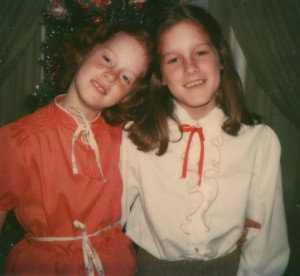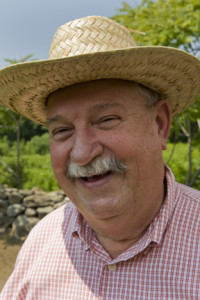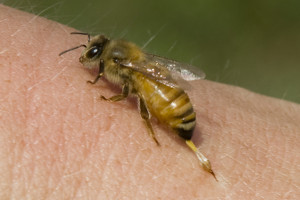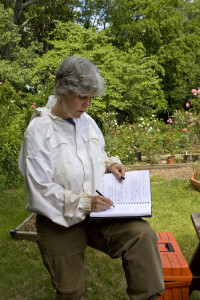I’m happy to report that Houghton Mifflin Harcourt, publisher of The Hive Detectives, has created a Discussion & Activity Guide for the book, complete with common core connections. Download the full PDF file by clicking this link: Discussion Guide.
The Bears and the Bees
© Loree Griffin Burns
The White Oak Land Conservation Society‘s Wildlife Saturdays programming this spring has been dubbed The Bears and the Bees. On March 19, Laura Hajduk, Black Bear Project Leader for the Division of Fisheries and Wildlife, talked about her work with black bears here in Massachusetts. And this week, I’ll be giving a family presentation on honeybees.
Yes, admission is free.
Yes, you can buy local Worcester county honey at the door.
Come one, come all!
Wildlife Saturdays: Honeybees
A Family Presentation by Loree Griffin Burns
Satuday, April 2, 2011 at 11 am
Holden Senior Center
1130 Main Street
Holden, MA
Springing
© Benjamin Griffin Burns
The bright side of all this snow on the ground in central Massachusetts is the ease with which one can, say, track a porcupine in the woods. The prickly fellow in the photo above, for example, lives behind our house, and we find him most afternoons perched thirty feet above the melting slush, chewing bark and branches in the sun. Seeing him reassures me that spring is on the way, although I don’t believe porcupines are generally considered harbingers of spring. (February in New England can make one see spring everywhere. This I know for sure.)
Other (equally dubious?) signs of spring ’round here include a sudden burst of online activity related to THE HIVE DETECTIVES:
I was a guest blogger at Cynsations yesterday; you can read my post and join the conversation about nonfiction genres here.
Mary Quattlebaum at Washington Parent compiled a nice list of books to help us all welcome the growing season and warmer weather, and she included THE HIVE DETECTIVES. You can her full list of titles here.
And Ricklibrarian posted this nice review at his blog.
I’m heading south for Newport’s March Into Reading literacy festival this weekend. I’m betting I’ll see actual grass down there. And maybe crocuses?
SB&F Fun
The SB&F Prize for Excellence in Science Books, coordinated by the wonderful editors at the review journal Science Books and Films (SB&F) and sponsored by the science-loving folks at Subaru, were awarded this past weekend at the annual conference of the American Association for the Advancement of Science (AAAS). In case the abundance of acronyms have you doubting there was much fun to be had, allow me to elaborate …
They painted our book cover onto the hood of a Subaru:
And since I couldn’t drive the car inside the convention center, I posed on top of it instead:
Ellen Harasimowicz and I signed books beside it, too:
And I met Ms. Frizzle! Okay, not exactly Ms. Frizzle … but I did meet Joanna Cole and Bruce Degan, creators of the Magic Schoolbus books and SB&F Prize winners in the picture book category (below, right). And I met Sean Connolly, too, the SB&F Prize winner in the hands-on category (below, left). Here we all are clutching our fancy new awards:
Call me crazy, but that was fun!
Thank you to Subaru, AAAS, SB&F, Heather Malcomson, Terry Young, Maren Ostergard and all of the scientists, librarians, editors, and book lovers who helped make this weekend celebration of science books for kids such a blast.
All photos © Ellen Harasimowicz
Cheers for the CYBILS
© Painting by Catherine Griffin Burns
The 2010 Children’s and Young Adult Bloggers’ Literary Awards (CYBILS) finalists were named on January 1st and I was thrilled and honored to see THE HIVE DETECTIVES on the Middle Grade/Young Adult Nonfiction List. Thank you, CYBILS judges! And thank you, Kate Messner, for nominating THD in the first place.
CYBILS are awarded in eleven categories, and this year more than 1200 books were nominated. I served as a first round judge for the inaugural CYBILS back in 2006, and this number stupefies me. That’s a lot of books to read and ponder in a very short time frame, especially a time frame that spans the holiday season. Signing on to do so may, in fact, be the ultimate definition of Kidlit Book Love. Those judges rock.
A final, wild Hooray! for the surprising number of titles that I’d not seen before these lists were announced. How did I miss so many great 2010 books? I don’t know, but I’m glad the CYBILS judges pointed a spotlight on them before the world moved on to a brand new publishing year.
If you love kids books and would like to learn more about the CYBILS, follow the links above. Be sure to check out the book categories closest to my science geek heart, Nonfiction for Middle Grade/Young Adults and Nonfiction Picture Books. And if you decide to treat yourself to a book or two, consider ordering them through the CYBILS website; this is the simplest way to thank the amazing kidlit bloggers who pour their time, energy, and passion into celebrating great books for kids.
Behind the Bee Book Posts: A Summary
2010 was a honey of a year for me, what with the publication of THE HIVE DETECTIVES and all. It’s been a treat to mark the sweetness by sharing the stories and the people who helped me bring the book into the world. Thanks to all of you who have read the stories, commented on them, and shared them. Here’s a link list for the entire series of posts.
Part 1: My friend, Linda
Part 2: Erica Zappy
Part 3: Ellen Harasimowicz
Part 4: Jennifer O’Keefe
Part 5: Mary Duane
Part 6: The Hive Detectives
Part 7: Gus Skamarycz
Part 8: My sister, Karin
Enjoy!
Behind the Bee Book: Part 8
When I visit schools, I tell kids that at the top of my favorite-parts-of-writing-a-book list is the dedication. I usually write it after all the research is done, the writing is finished, the editing is finalized, and the book is ready to be printed. I take a deep breath, think about all the experiences that have helped to shape the book, and to shape me as its author, and choose one person to whom I would like to pay tribute.
For me, for this book, that person was my sister Karin. Karin is twenty years younger than me (not really, but she’d want me to tell you so) and is one of the most genuinely compassionate people I know. This is the girl who would give you her car keys if you really and truly needed them, and she would not think to ask if you have a driver’s license. She doesn’t care. You are in need, and she can help. So she does. I’ve always admired this about her.
While I was writing THD, Karin moved from outside of Boston where we grew up to the boonies, where I live. I wonder now how I got along without her. She lives around the corner and is Auntie K, the person my kids turn to when I am being unreasonable and refusing them everything. She is also the person I turn to when I need help, whether it’s a gallon of milk or a day of childcare or an ear to chew. Without her to handle the rustle-them-up-and-get-them-off-to-school morning routine with my kids, I simply wouldn’t have been able to do school visits the past two years. And there were plenty of afternoons when she has handled the greet-them-off-the-bus-and-feed-them-a-snack part of the day, too. It would have been so much harder to write this book—and get through our day-to-day life—without her. Which is why if you open THE HIVE DETECTIVES to the first page, you’ll see this dedication:
For my sister, Karin
And in case this final post in my ‘Behind the Bee Book’ series is feeling a bit too lovey-dovey and mushy, you should also know this: my sister Karin hates bees. With. A. Passion.
(Tee Hee!)
Thanks for everything, sis. I love you more than bees!
Behind the Bee Book: Part 7
This fellow, Gus Skamarycz, stung me with a honey bee. Here’s the proof, which can also be found on page 41 of THE HIVE DETECTIVES:
What more can one say, except Thank you, Gus!
I’ve got one final post in this Behind the Bee Book blog series, which I’ll tack up tomorrow. My feelings of thankfulness and good fortune, however, will likely go on for some time …
Behind the Bee Book: Part 6
People often ask me where I get ideas for book projects, and I tell them the truth: all over the place. In the woods. From my friends. Hanging on trees. I know this isn’t true for all writers, but for me, ideas are the easy part. It’s the next step that I find daunting: pursuing the scientists I want to write about and convincing them to help me tell their story. It takes tact and, to be honest, a level of persistence that is sometimes uncomfortable for me.
You see, to convince a publisher to offer a book contract, I need to assure them I’ve got access to all the information I need to make the book, for example, that the scientists I am writing about are on board. But the easiest way to get the scientists on board is to tell them I have a book contract. Which I usually can’t get until I convince them to get on board. It can be an awkward little dance, and for THE HIVE DETECTIVES, that dance began at the 2007 conference of the Eastern Apicultural Society.
I’d been researching the CCD story for months and learned that this conference was going to bring together a group of scientists pursuing various lines of CCD research. Despite the fact that I hadn’t even pitched the book to my publisher yet, I began spending the advance: I registered for the conference and set out for Delaware.
I heard Dennis vanEngelsdorp speak on the first day and although I hadn’t planned to approach him, found myself in an elevator with him and a few of his colleagues shortly after. I did a mental dash through my elevator pitch, marveled at the fact that I was actually going to give it in an elevator, took a deep breath … and decided not to say a word.
Hey, I never said I was good at this.
Back in my conference dorm room, though, I psyched myself up for a second chance. And then I made sure I got one. I found Dennis after another talk and told him about the book I was hoping to create for young readers. His response was enthusiastic, and he gave me the sort of inside information that is crucial at this stage in a book project: the names of some scientists I should talk to, and permission to tell them he’d sent me their way. And so, back home and with a book proposal well underway, I contacted Jeff Pettis, Maryann Frazier, Diana Cox-Foster and Dave Hackenberg. Thanks in large part to Dennis’ introduction, each agreed to be part of my project. Not long after, I got my book contract.
There followed an abundance of interviews, lab tours, apiary tours, and follow-up questions with the hive detectives. It was a lot to ask of men and women on the front lines of an international pollinator crisis—but these particular men and women happen to have not only a sincere passion for their work, but a dedication to sharing it. Thank you Jeff, Maryann, Diana, Dave, and Dennis. I appreciate every interview, tour, lesson, answered email, and borrowed photograph; THE HIVE DETECTIVES is a better book for all of it.
Behind the Bee Book: Part 5
When I met Mary Duane, president of the Worcester County Beekeepers Association, I had no plans to include her in THE HIVE DETECTIVES. I was, however, super excited to take her up on her offer to show me around a box hive. Working with Mary in her bee yard was the perfect way to rest my brain as I puzzled my way through the writing of the THD manuscript.
And let me tell you, about halfway through the first draft, my brain needed a rest. I’d realized that the story I was telling—the story of Colony Collapse Disorder (CCD)—was hard to write about without using a lot of unusual bee terms, and defining all these terms was killing the dramatic tension I was trying to build. Also, the ending I was building up to was dire (maybe too dire?); I wasn’t sure how to temper this.
So I rested my brain while working bees with Mary. She taught me how to inspect a hive, how to find the queen, how to recognize the signs of a colony preparing to swarm, how life in the hive was tied to the weather and the bloom, how to collect honey. Over one spring, summer, and fall, I learned how to keep bees, and in the process—bonus of bonuses—I discovered the answer to my manuscript dilemmas: Mary herself.
By bringing readers into one of Mary’s hives at the very start of the book, I was able to introduce all those pesky bee terms. When they came up later, readers already knew what they meant and so they weren’t a distraction to the drama of the CCD story. And to balance that visit into Mary’s hives at the beginning, I decided to include a return trip at the end of the book; readers learned how to collect honey and got a sense that some bees—in particular, Mary’s bees—were doing all right, despite the mysterious scourge called CCD.
Thank you, Mary, for sharing your knowledge and your bees, and for not hesitating when I said,














